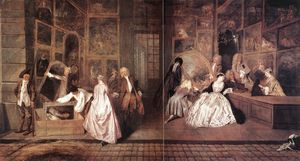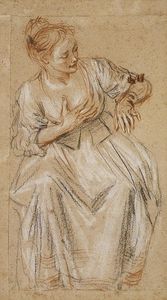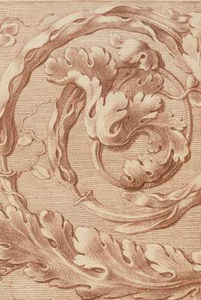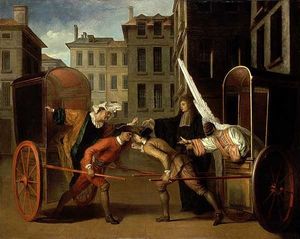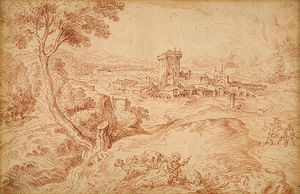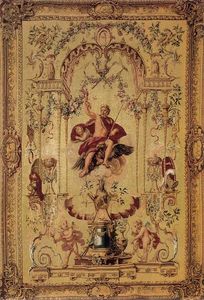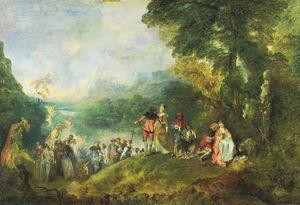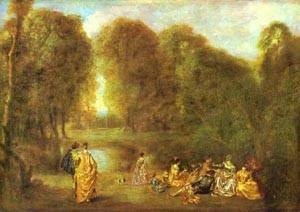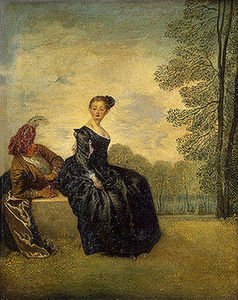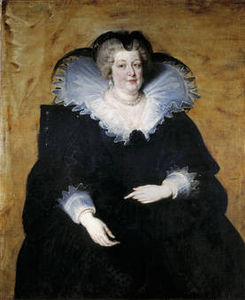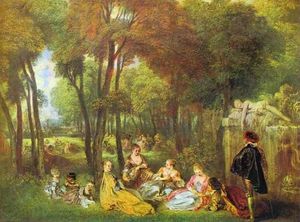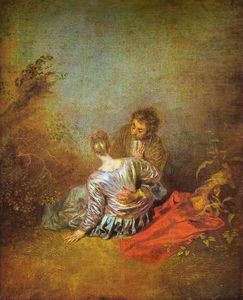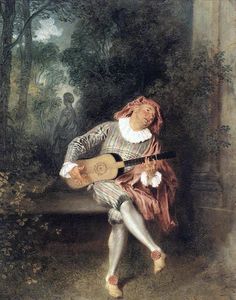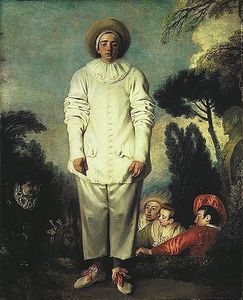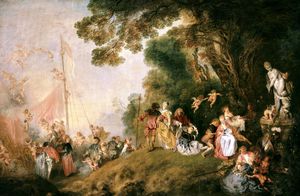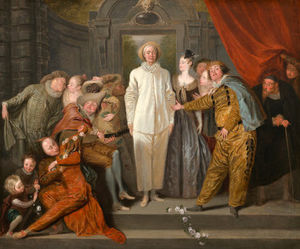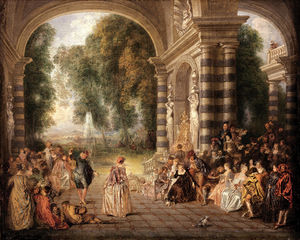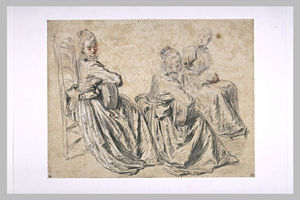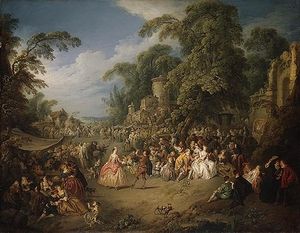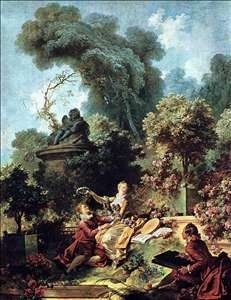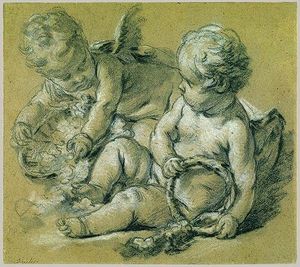Antoine Watteau
- Full Name:
- Jean-Antoine Watteau
- Short Name:
- Watteau
- Date of Birth:
- 10 Oct 1684
- Date of Death:
- 18 Jul 1721
- Focus:
- Paintings, Drawings
- Mediums:
- Oil, Metal, Stone
- Subjects:
- Figure, Landscapes, Scenery
- Art Movement:
- Rococo
- Hometown:
- Valenciennes, France
Introduction
Jean-Antoine Watteau is attributed to extending the bounds of the 18th century French-born Rococo at period beyond architecture, furniture and sculpture and into painting. In comparison to other movements the Rococo was short lived, perhaps due to Watteau's untimely death at the age of 36, just as his career was flourishing.
Still, he was attributed to developing a unique style and revolutionizing the art world through his individuality. This was seen not only in the themes of his theatrically-influenced work but also in his ornate and airy style.
As well as his painting skills, Watteau was perhaps one of the most brilliant and innovative draftsmen of the eighteenth century, displaying a fascinating talent with the "trois-crayons" or "three-chalk" technique. His drawings have the rich coloristic effects of painting and his work Seated Woman is a prime example of his mastery of the technique.
Watteau's influence on the art world, encompassing costume, film, poetry, music was more extensive than that of almost any other eighteenth century artist. He had many followers during his career but also a lot of critics. Despite his reputation diminishing with the fall of Rococo, it was restored after the French Revolution.
Antoine Watteau Artistic Context
Rococo developed first in the decorative arts and interior design. Louis XV's succession brought a change in the court artists and general artistic fashion. By the end of the old king's reign, rich Baroque designs were giving way to lighter elements with more curves and natural patterns. These elements are obvious in the architectural designs of Nicolas Pineau.
During the Régence, court life moved away from Versailles and this artistic change became well established, first in the royal palace and then throughout French high society. The delicacy and playfulness of Rococo designs is often seen as perfectly in tune with the excesses of Louis XV's regime.
Watteau's artistic content could be summarized by two major influences: his love for the theater and his fascination of the Rococo styling and design.
Spending his early years in Paris in the workshop of set designer Claude Gillot, Watteau gained his love for the theater, specifically for the Italian Commedia dell'Arte and its innumerable characters. Shortly after, he worked for interior designer Claude Audran III and picked up Rococo design influences.
Watteau's attraction to Rococo's curving lines and decorative nature became central to his later work. As his career progressed the artist combined his love for the theater and his fascination of the Rococo styling and design and developed a truly unique style of painting with ornate elegance that gained him critical attention.
Watteau is most known for his grand themes and for being one of the best draftsmen of the 18th century.
Antoine Watteau Biography
Early years:
Little is known about the early years of Watteau's life and details of his family life and upbringing are scarce. Though, it has been said that his menacing father was a roofer and that the financial position of his family was a modest one.
The artist's life is chronicled in greater depth after his move to Paris in 1702.
Middle years:
As for most artists, Paris was where the excitement began for Watteau. Here his artistic ability grew and his unique style developed. Watteau's first job at a workshop painting reproductions of popular Dutch artists aided in the development of his characteristic sketch-like technique.
In 1704, he became the assistant of Claude Gillot, an artist who favored the more official and serious art of Louis XIV. Gillot was a set designer and acquainted young Watteau with the Commedia dell'Arte. Watteau wholeheartedly embraced the characters of the Italian theater, an influence that would last throughout his short career.
Watteau's second apprenticeship was with an interior designer by the name of Claude Audran III. Through Audran, Watteau was exposed not only to Rococo design ideals but to the work of Peter Paul Rubens which remained influential throughout Watteau's life.
Aiming to create his own original work, Watteau entered the Prix de Rome (a scholarship for art students) at the Royal Academy of Painting and Sculpture in 1709. He didn't win but gained the recognition of the Academy's president upon his second entrance.
In 1712, he was granted the chance to submit work for admission into the Academy. After completing his submissions piece, Embarkation for Cythera five years later, Watteau was granted full admission. Furthermore, as Watteau's style did not fit into any preexisting categories at the Academy, he was accepted under his own genre, "fete gallants" or grand themes.
Later years:
During his final years Watteau continued painting acclaimed pieces. After being diagnosed with tuberculosis, his health continued to decline and resulted in his untimely death on July 18, 1721, at the age of 36.
Antoine Watteau Style and Technique
Watteau was the innovative artist who extended Rococo beyond architecture, interior design and sculpture and onto the canvas. The notable elements that make Watteau's style unique are the combination of his lofty content and his brightly colored landscapes.
Besides the theme of his work, humans at one with nature, Watteau is probably mostly praised for his bright palette. He revived colors previously seen in 16th century Venetian paintings and together with his idealized, flirty themes and aesthetics of Rococo décor, he stunned critics of the day.
Watteau's palette and subject matter somewhat overshadowed his technique and this led to critics challenging his stylistic ability. They accused Watteau of being "deficient in the art of composition. " He had yet to conquer showing figures in differing depths and when it came to form, he did not see in flowing curves but in tight, straight lines.
Furthermore, the perspective of Watteau's paintings is relatively simple; his viewpoint is at eye level for the viewer. He paints his figures close to true to life with proportionate bodies, all relative in size to another.
Despite this, Watteau's drawing style has made him one of the most brilliant and innovative draftsmen of the eighteenth century. He displayed a fascinating talent with the "trois-crayons" or "three-chalk" technique. His drawings, with their rich coloristic effects of painting, grace the walls of the most prestigious art museums today.
Who or What Influenced Antoine Watteau
The Theater
Commedia dell'arte (literally, "comedy of professional artists" ) is a theatrical form characterized by improvised dialogue and a cast of colorful stock characters that emerged in northern Italy in the fifteenth century and rapidly gained popularity throughout Europe. It was usually performed in the open air by traveling troupes of players
-

-

Throughout his lifetime, Jean-Antoine Watteau drew inspiration from many sources. His greatest, and perhaps most influential period was that spent in Paris.
Claude Gillot & Claude Audran III:
In this epicenter for creativity and free thinking, Watteau met and worked with Claude Gillot, a set designer for the theater as well as interior decorator Claude Audran III. He drew the theme of his work from Gillot, and the Rococo style from Audran.
Watteau wholeheartedly embraced the characters of the Italian theater and Gillot's influence would play a major role in his art of make-believe and illusions, a theme that would last throughout his career.
It was at Audran's workshop, that Watteau was exposed to more natural and organic reflections, such as the S curve, or shell like shape. Watteau incorporated this idea into his airy brushstrokes.
Audran also introduced Watteau to Peter Paul Ruben's series painted for Queen Marie de Medici - a collection that changed Watteau's style as he evolved into his more formal period.
After seeing this he began to draw with ornate elegance and in the truest style of Rococo. He was the first to bring such a style of elegance to the canvas. It had been only previously seen in architecture, interior design and pottery.
Watteau copied works by Rubens and sixteenth-century Italian artists in the collection of Pierre Crozat (a wealthy banker and art collector). Like Rubens, Watteau would also sketch his works before creating the final piece as well as following the great master's utilization for the same materials such as various crayons and chalks.
Nature:
Watteau drew inspiration mainly from nature and his time spent in the Luxembourg gardens, which is evident in his scenic landscapes.
In a similar fashion, Watteau ignored society's previous expectations of the turgid life and embraced the lofty notion of people enjoying the freedom of their own lives and becoming one with nature.
In some of his paintings, the aristocrats of his day reenact scenes from the comedies, with nature as their backdrop. In others, he depicts actual characters on a real stage.
Antoine Watteau Works
Antoine Watteau Followers
During life:
Watteau had a few fellow artists follow his lead during the Rococo era. His closest follower and only student was Jean-Baptiste-Joseph Pater. Pater had similar interpretations of how humans should enjoy life and critics and historians are said to have stated that Pater's reputation almost equaled his teacher's.
Although they may not have studied first hand with Watteau, virtually every artist working in eighteenth-century France owes a major debt to Watteau's inspiring fêtes galantes and trois crayons (three colors of chalk) drawings. Such debtors include François Lemoyne, François Boucher, and Jean-Honoré Fragonard.
Watteaus's influence cannot go unnoticed in the work of artist Jean-Honoré Fragonard in particular, who further elaborated the Rococo idiom established by Watteau. It is evident in his painting The Lover Crowned, that he too, as well as his subjects, favored the playful, the erotic and the joys of domesticity.
François Boucher's Two Winged Putti displays the artist's great technique with chalk as a medium. This is certainly a skill adapted from his time spent employed by Jean de Jullienne where his task was to make etchings after drawings by Watteau. If subject matter and content do not match, certainly Boucher's facility with chalk, blending of the colors, the creation of shadows and highlights is a direct influence of Watteau's chalk drawings.
After death:
Watteau's influence on the aesthetic of Rococo décor, as well as his preference for erotic genre subjects was greatly admired and adopted by fellow Rococo artists. Watteau's artistic legacy pervades French art up to the emergence of Neoclassicism.
After the death of Watteau, Rococo was already beginning to fade from the art scene as the Revolution was on its way. Still, Watteau's technique and painting style was undoubtedly revived during the Impressionist movement with regard to his painting techniques and color palettes.
His unique style continued to trickle down to his predecessors, who were able to continue his legacy and adapt Watteau's originality into their own work.
Antoine Watteau Critical Reception
Watteau's influence on the arts was more extensive than that of almost any other eighteenth century artist. As can be expected, Watteau had devout followers and critics during his life and after his death. His reputation dwindled with the fall of Rococo, but after the French Revolution it was restored once again.
Contemporary reception:
Watteau's acceptance into the prestigious Academie de Peinture is proof of the positive impression he made on his modern day critics. Judges at the Academie were impressed with his bright palette and his aesthetic of Rococo décor and they even accepted Watteau under a category of his own, "fete gallantes" or 'grand themes'.
Posthumous reception:
Some critics in favor of his work praise Watteau for his treatment of light and credit him with bringing back laughter and liberty with his "fetes galantes". Yet others have challenged Watteau's stylistic ability accusing him of being "deficient in the art of composition" and not being able to relate figures in depth.
A year after Watteau's death, a harsh critic of his work, Madame de Pompadour, came to the fore;
"There are apes dancing, riding, swinging, carrying flags, painting, playing music, bathing, and dressing, but nothing is caricatured. Watteau has only sought effect in graceful, piquant, and ingenuously-chosen posing... But we must not attach too much importance to this work; in the richness of its detail we can appreciate the fertility of the artist's imagination, but it was impossible for him to give scope to his best qualities in these isolated figures detached upon a white ground; all effects of chiaroscuro and light were absolutely interdicted."
Modern day reception: Watteau is still capturing the interest of modern day art critics and he was the subject of New York based Jed Perl's newest book, Antoine's Alphabet: Watteau and His world (2008).
Antoine Watteau Bibliography
To find out more about Watteau and his works please choose from the following recommended sources.
• Lauterbach, Iris. Antoine Watteau: 1684-1721. PLACE, 2008
• Mollett, John William. Watteau. Kessinger Publishing, LLC, 2007
• Perl, Jed. Antoine's Alphabet: Watteau and His World. Random House, 2008
• Posner, Donald. Antoine Watteau. Cornell University Press, 1984
• Rogers, Robert Emmons. Behind A Watteau Picture: A Fantasy in Verse in One Act. Kessinger Publishing, LLC, 2007
• Sheriff, Mary D. Antoine Watteau: Perspectives on the Artist and the Culture of His Time. University of Delaware Press, 2006
• Stranahan, C. H. A History of French Painting From the Earliest To It's Latest Practice. Charles Scribner's Sons, 1918
• Zeri, Federico. Watteau: The Embarkation for Cythera. NDE Publishing, 2000


